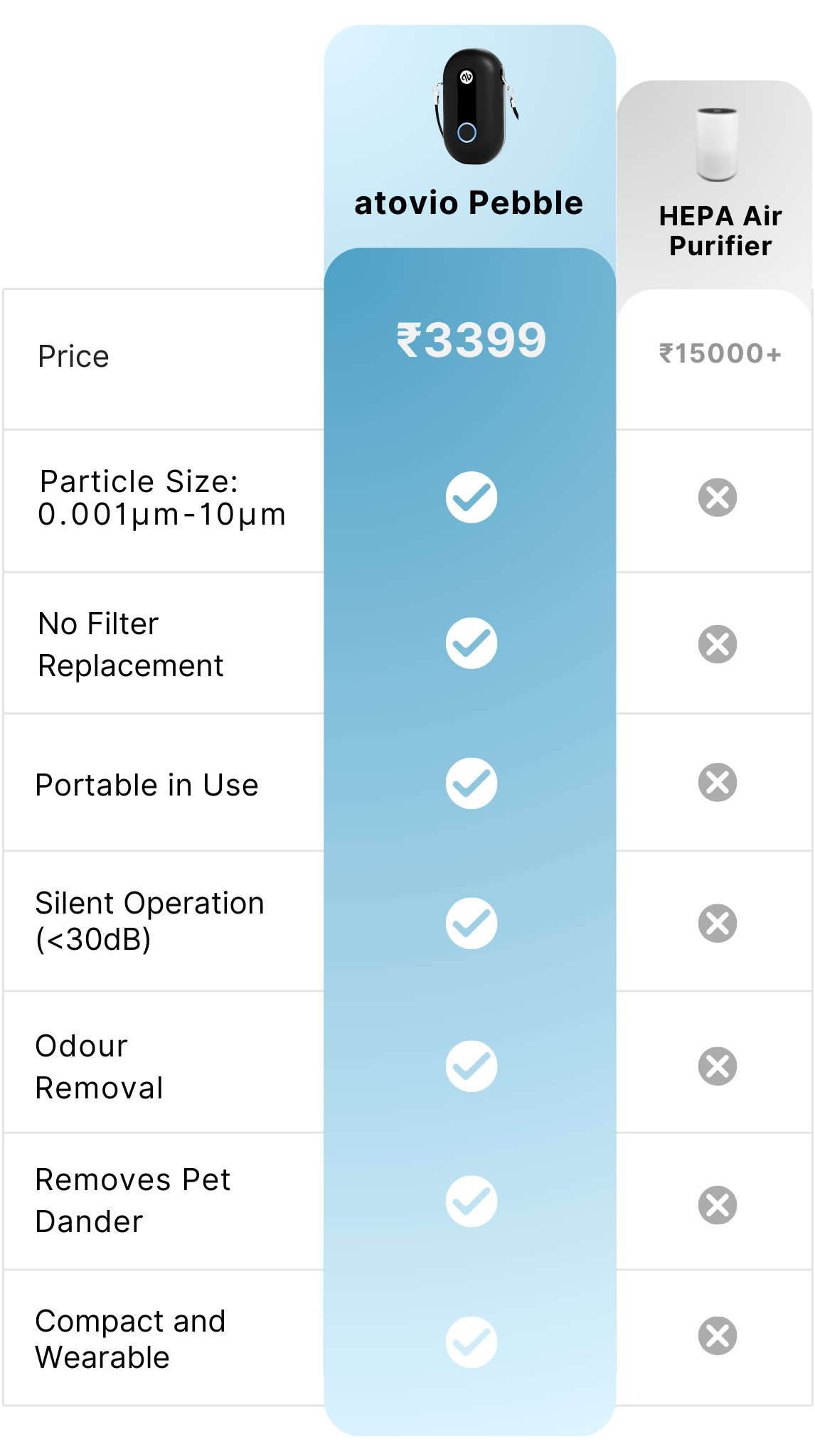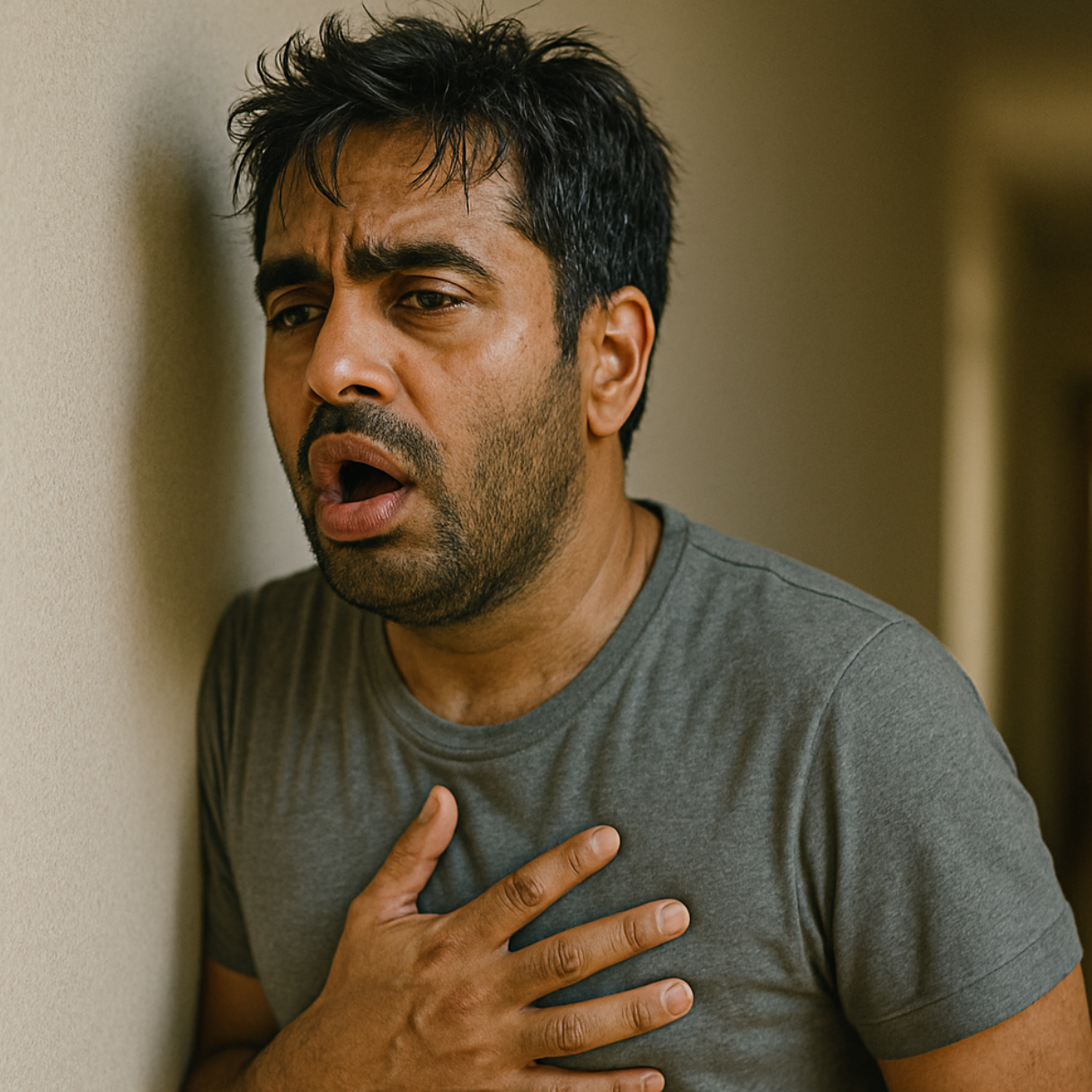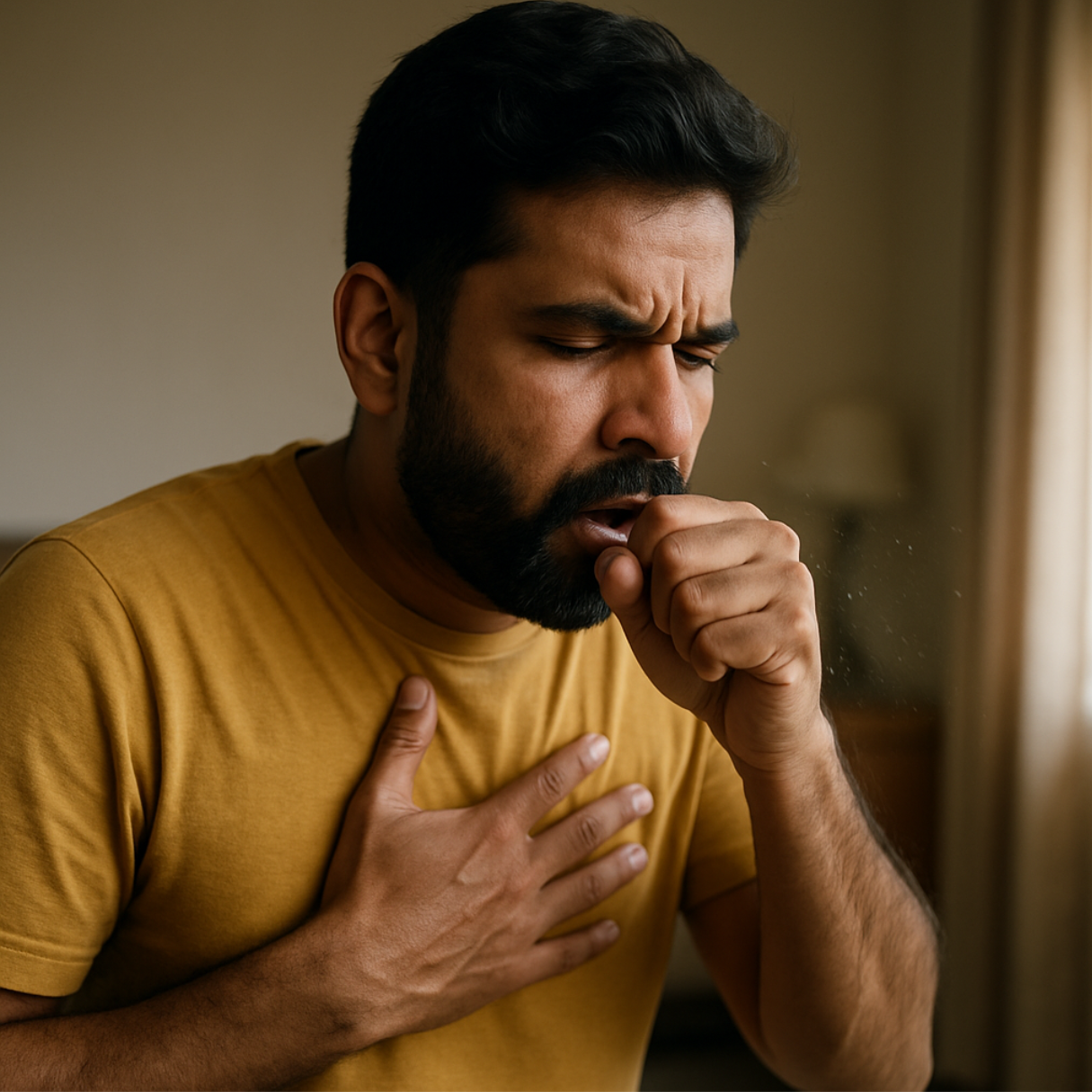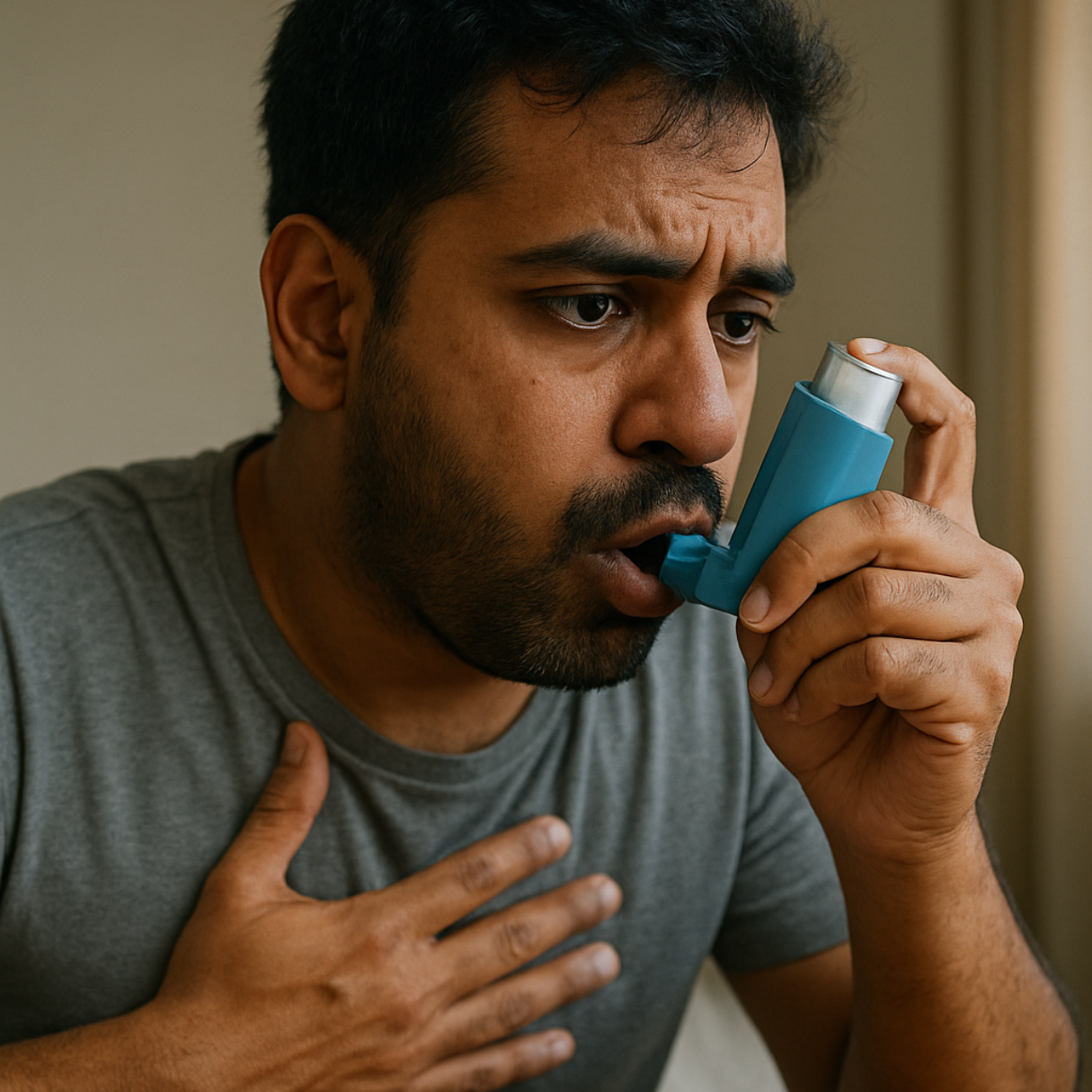Dense Pollution Cleared
in 30 Seconds

India's Most Effective
Portable Air Purifier
atovio Pebble- Your Personal Air Purifier
From One Parent to Another
Breathing shouldn’t be Scary
Breathing shouldn’t be Scary
An average child breathes over 22,000 times a day - taking in 10,000 to 12,000 litres of air.
But most of that air is polluted which your child breathes. Every second. Every breath.
That’s why we created the atovio Pebble.
Because we hear you. And we care like you do.
Breathe Better: Stories,
Science and Support
Pollen allergies, also known as seasonal allergic rhinitis or hay fever, affect millions of people worldwide, causing sneezing, itchy eyes, congestion, and breathing difficulties. In India, cities like Bangalore, Delhi, and Mumbai experience some of the highest pollen concentrations, making allergy symptoms a year-round struggle for many residents.
Pollen grains—microscopic particles released by trees, grasses, and weeds—become airborne and trigger immune system responses in sensitive individuals. The allergy season varies by region and plant type:
-
Tree pollen dominates in spring (March-May)
-
Grass pollen peaks in summer (June-August)
-
Weed pollen surges in autumn (September-November)
-
Winter (December-February) sees fewer pollen allergens but an increase in dust and indoor irritants
With rising pollution levels and climate change, pollen exposure is worsening in urban areas, making it crucial to understand triggers, seasonal patterns, and effective relief methods to manage symptoms and breathe easier.
Why Do Pollen Allergies Occur?
Pollen grains from trees, grasses, and weeds contain proteins that, when inhaled, cause the immune system to overreact. This leads to the release of histamines, triggering symptoms such as:
-
Runny or stuffy nose
-
Watery, itchy eyes
-
Sneezing and congestion
-
Sinus pressure and headaches
-
Fatigue and difficulty breathing
-
Asthma flare-ups in sensitive individuals
Common Pollen Allergy Triggers in India
India’s diverse plant ecosystem makes pollen allergies a year-round issue. Some of the most common pollen allergens include:
-
Tree Pollen: Peaks in spring & early summer from trees like Acacia, Casuarina, and Prosopis.
-
Grass Pollen: High during late summer from Bermuda grass, Parthenium, and Ryegrass.
-
Weed Pollen: Plants like Ragweed, Amaranthus, and Sagebrush release allergy-triggering pollen in the fall.
-
Crop Pollen: Regions with wheat, mustard, and rice farming have high pollen exposure.
-
Urban Pollution & Pollen Mix: In cities like Delhi and Mumbai, air pollution exacerbates pollen allergies, making symptoms more severe.
Ways to Manage Pollen Allergies
Minimizing pollen exposure and improving air quality can help control seasonal allergy symptoms. Here’s how:
-
Check daily pollen forecasts and limit outdoor activities during peak pollen times.
-
Shower & change clothes after outdoor exposure to remove pollen from skin & hair.
-
Keep windows closed during high pollen seasons to prevent allergens from entering indoor spaces.
-
Wear sunglasses & masks outdoors to reduce pollen contact with eyes and nasal passages.
-
Wash bedding and clothes frequently to remove pollen buildup indoors.
-
Drink warm fluids to soothe sinus inflammation and clear nasal passages.
Breathe Easier with Pollen-Free Air
Pollen allergies can make daily life uncomfortable, but proactive steps can help significantly reduce symptoms. Understanding triggers, seasonal changes, and protective measures can help allergy sufferers manage their condition effectively and breathe cleaner, healthier air year-round.
✅ Take control of your allergies and breathe easier every season with atovio!
We breathe nearly 22,000 litres of air every day, but how often do we consider what's in it? From smoggy skies to indoor irritants, air pollution is more than just a haze-it’s a cocktail of harmful particles and gases that directly impact our health. Understanding the major air pollutants, their sources, and effects is the first step in protecting ourselves and advocating for cleaner air.
What Is Air Pollution?
Air pollution refers to the presence of harmful substances in the atmosphere that pose health risks and environmental damage. These pollutants can be natural (like dust storms) or human-made (like vehicle emissions). Air pollutants are broadly categorized into particulate matter and gaseous pollutants.
Major Air Pollutants, Their Sources, and Health Effects
1. Particulate Matter (PM2.5 and PM10)
-
Sources: Vehicle exhaust, industrial emissions, construction dust, crop burning
-
Health Effects: Penetrates lungs and bloodstream; causes asthma, heart disease, and lung cancer
2. Nitrogen Dioxide (NO2)
-
Sources: Fossil fuel combustion from cars, power plants, and factories
-
Health Effects: Inflammation of airways, reduced lung function, respiratory infections
3. Sulfur Dioxide (SO2)
-
Sources: Burning coal or oil in power plants and industries
-
Health Effects: Breathing problems, eye irritation, worsens conditions like asthma and bronchitis
4. Carbon Monoxide (CO)
-
Sources: Incomplete combustion of fossil fuels, car exhaust, indoor heating appliances
-
Health Effects: Reduces oxygen delivery in the body, causes fatigue, dizziness, and can be fatal in high concentrations
5. Ozone (O3) (Ground-level)
-
Sources: Reaction of sunlight with pollutants like VOCs and NOx
-
Health Effects: Chest pain, throat irritation, worsens bronchitis and emphysema
6. Volatile Organic Compounds (VOCs)
-
Sources: Paints, cleaning agents, air fresheners, vehicle exhaust
-
Health Effects: Headaches, liver/kidney damage, possible carcinogenic effects
7. Ammonia (NH3)
-
Sources: Agricultural activities, fertilizers, livestock waste
-
Health Effects: Eye and skin irritation, respiratory distress
8. Lead
-
Sources: Batteries, smelting, outdated fuels
-
Health Effects: Developmental issues in children, kidney and nervous system damage
Air Pollution in India: A Snapshot
-
India has 14 of the world’s 20 most polluted cities according to the IQAir 2023 Report
-
Over 1.6 million deaths in India were linked to air pollution in 2019 (The Lancet)
-
In Delhi, PM2.5 levels frequently exceed 300 µg/m³, well above the WHO safe limit of 5 µg/m³
Who Is Most at Risk?
-
Children & Elderly: Weaker immune systems, higher vulnerability
-
People with Preexisting Conditions: Asthma, COPD, cardiovascular disease
-
Urban Dwellers: High exposure to vehicle and industrial emissions
-
Outdoor Workers: Construction workers, traffic police, delivery agents
How to Minimize Exposure to Air Pollutants
-
Check AQI levels daily and limit outdoor activity on poor air quality days
-
Use air purifiers indoors
-
Wear N95 masks in high-pollution zones
-
Wear a portable air purifier whenever stepping out.
-
Keep indoor spaces well-ventilated
-
Avoid burning candles, incense, or smoking indoors
Clearer Skies, Healthier Lives
Air pollution is a silent but serious threat. By understanding what pollutants are in the air and where they come from, we can make smarter choices for our health and push for cleaner, more sustainable policies.
Protect yourself from pollution while commuting! Buy atovio Pebble today!
Air pollution is a growing global health crisis, with particulate matter (PM2.5 and PM10) being some of the most dangerous airborne pollutants. These fine particles, often invisible to the naked eye, can penetrate deep into the respiratory system, leading to severe health issues ranging from asthma and lung disease to cardiovascular complications and even neurological disorders.
Understanding what PM2.5 and PM10 are, their sources, and their health risks is crucial to making informed decisions about air quality and personal protection.
What is Particulate Matter (PM)?
Particulate matter (PM) refers to a mixture of tiny solid particles and liquid droplets suspended in the air. These pollutants come from natural sources like dust and wildfires, as well as human activities such as vehicle emissions, industrial pollution, and construction dust.
Difference Between PM2.5 & PM10
-
PM2.5 (Fine Particulate Matter) – Particles smaller than 2.5 micrometers in diameter. They can penetrate deep into the lungs and enter the bloodstream, posing serious health risks.
-
PM10 (Coarse Particulate Matter) – Particles smaller than 10 micrometers in diameter. They primarily affect the upper respiratory tract, causing irritation and breathing difficulties.
Major Sources of PM2.5 & PM10
-
Traffic emissions (vehicles, diesel engines)
-
Industrial pollution (factories, power plants)
-
Construction dust (cement, road dust)
-
Burning of fossil fuels (coal, biomass, crop burning)
-
Wildfires and household cooking smoke
Health Implications of PM2.5 & PM10 Exposure
Shocking Statistics on Particulate Matter & Health
-
According to the World Health Organization (WHO), air pollution is responsible for 7 million premature deaths annually, with PM2.5 being a major contributor.
-
A study published in The Lancet found that India accounts for over 1.67 million air pollution-related deaths per year, making it one of the most affected countries.
-
The Global Burden of Disease Study reported that long-term exposure to PM2.5 increases the risk of lung cancer by 36% and heart disease by 29%.
-
Research shows that children exposed to high PM levels experience a 15% reduction in lung function growth, increasing their risk of chronic respiratory conditions later in life.
Short-Term Effects:
-
Irritated eyes, nose, and throat with elevated hair loss
-
Coughing, sneezing, and difficulty breathing
-
Increased risk of asthma attacks
-
Shortness of breath and lung irritation
Long-Term Effects:
-
Chronic lung diseases such as COPD and lung cancer
-
Increased risk of heart disease, stroke, and high blood pressure, diabetes
-
Neurological disorders and cognitive decline
-
Higher risk of pregnancy complications and developmental issues in children
How to Reduce Exposure to PM2.5 & PM10
-
Monitor AQI levels and limit outdoor activities during high pollution days.
-
Wear masks (N95/N99) to filter out harmful particles.
-
Improve indoor air quality by reducing dust, smoke, and chemical pollutants.
-
Use air purification methods to remove fine particles from the air.
Protecting Yourself from Particulate Matter
PM2.5 and PM10 are among the most dangerous pollutants, impacting millions worldwide. By understanding their sources and health risks, individuals can take proactive steps to reduce exposure and improve air quality, ensuring better respiratory health and overall well-being.
✅ Stay informed, monitor air quality, and protect yourself from the invisible dangers of air pollution!
Meet Pebble, your personal air guardian! Small enough to wear around your neck, but mighty enough to shield you from the pollution around you.
In many cities across India and the world, pollution has become an accepted reality. People go about their daily routines despite smog-filled skies, high AQI levels, and worsening respiratory health. But should we really accept this as normal?
The truth is, long-term exposure to air pollution can have serious health consequences, including lung diseases, heart problems, and cognitive decline. Yet, many people continue to ignore or underestimate its effects simply because pollution feels like an unavoidable part of life.
This blog explores why people have become desensitized to pollution and how personal air purification solutions like atovio can help you take control of the air you breathe.
The Reality of Pollution in India
Shocking Facts About Air Pollution:
-
India has 125 of the world’s 145 most polluted cities.
-
9 out of 10 people globally breathe air that exceeds WHO’s safe pollution limits.
-
Air pollution contributes to over 1.6 million deaths in India annually.
-
Long-term exposure to PM2.5 and PM10 increases the risk of asthma, strokes, and lung cancer.
Yet, despite these alarming facts, many people continue to ignore the dangers of pollution and do little to protect themselves.
Why Do People Accept Pollution?
-
Lack of Awareness – Many don’t realize how dangerous long-term exposure to pollution is.
-
Adaptation Over Time – The body adjusts to poor air quality, but that doesn’t mean the air is safe.
-
No Immediate Solution – People feel helpless against large-scale pollution problems and assume there’s nothing they can do.
-
False Sense of Security Indoors – Many believe they are safe inside their homes, unaware that indoor air can be even more polluted than outdoor air.
How Can You Take Control of Your Air Quality?
Instead of accepting pollution as part of life, take steps to protect yourself:
-
Monitor AQI levels daily and limit outdoor exposure during high pollution periods.
-
Use personal air purifiers like atovio Pebble to reduce exposure to airborne pollutants.
-
Improve indoor air quality by using ventilation, reducing chemical-based products, and keeping spaces dust-free.
-
Adopt healthy habits like staying hydrated, wearing masks in high-pollution areas, and adding air-purifying plants at home.

How atovio Provides a Personal Pollution Shield
atovio’s Advanced Variable Anion Technology is designed to create a cleaner personal breathing space. Here’s how it helps:
-
Releases millions of anions that neutralize airborne pollutants like PM2.5, bacteria, and VOCs.
-
Scientifically validated at IIT Kanpur, showing up to 90% pollutant reduction.
-
Portable & filter-free, ensuring clean air anywhere—at home, in the office, or while commuting.
-
Helps combat urban pollution, reducing exposure in high-risk areas like metros, traffic zones, and workplaces.
You Don’t Have to Accept Pollution
-
While large-scale solutions take time, you can protect yourself immediately.
-
atovio Pebble offers a practical solution to breathe cleaner air anywhere.
-
Don’t accept pollution—fight it by making smarter air quality choices.
✅ Take charge of the air you breathe—Get atovio Pebble today!
Transform Your Family’s Health with Our Personal Air Purifier
Nature's Air Purifiers: The Power of Anions
atovio: Bringing Nature's Freshness to You
A Level Above in Every Way

Features of atovio Pebble
No Filter Replacement
Easy maintenance. Hassle free use.
Personal Air Zone
Your bubble of clean air anytime anywhere
Variable Anion Technology
Millions of anions neutralizing airborne pollutants
Compact & Wearable
Lightweight and easy to carry
Long Battery Life
40+ hours of continuous use
Quiet Operation
Your silent partner of clean air
Two Modes of Operation
Switch to turbo mode for higher performance
USB-C Charging
Quick and convenient charging
Easy Maintenance
Simple care for lasting performance
- Choosing a selection results in a full page refresh.
- Opens in a new window.






























